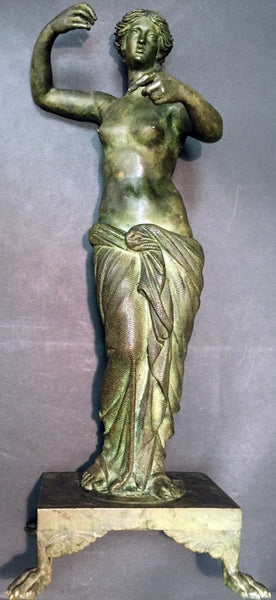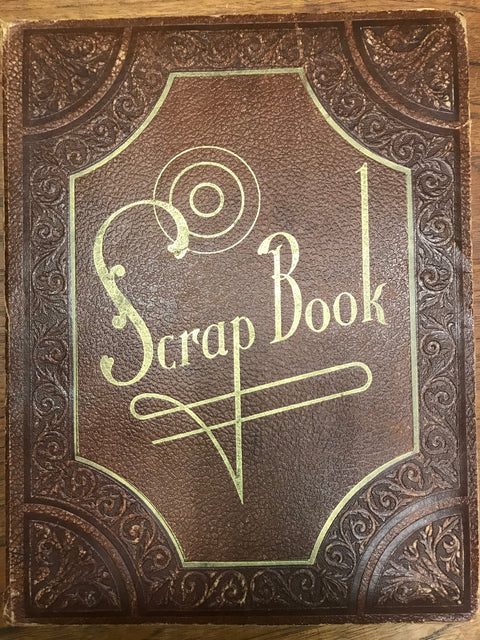Bronze Statue of Venus or Aphrodite of Capua signed Pietro Masulli. A very fine patinated statue after its prototype the Antique statue of "Venus or Aphrodite of Capua" by master sculptor Pietro Masulli who worked in Naples, during the Grand Tour 19th century Period. The goddess Venus or Aphrodite is represented semi-naked. Raised arms indicate that they probably held a shield, perhaps of Mars, used by the goddess to mirror herself. Bronze - Lost-wax casting technique 49.5 cm high

Venus Aphrodite Statue Bronze

Venus after Venus of Capua

Venus after Venus of Capua

Venere Afrodite

Pietro Masulli
Venus or Aphrodite of Capua is a statuary type representing a semi-naked Aphrodite. Its prototype, named after its findspot at the ruins of an ancient theater in Capua, Italy, is now in the Museo Archeologico Nazionale Napoli (Naples National Archaeological Museum). An earlier version of the type of the Venus de Milo, and close to the Venus of Arles, the statue probably represented the goddess admiring her reflection inside the reflective inner surface of Ares' shield, a motif known on coins from Corinth. C.M. Havelock, The Aphrodite of Knidos and Her Successors: A Historical Review of the Female Nude in Greek Art, University of Michigan Press, 2008.

Afrodite Capua Museo Napoli
Afrodite di Capua
Afrodite, stante sulla gamba destra, con il piede sinistro poggiato sull'elmo di Ares, è rappresentata seminuda, con unhimation riccamente panneggiato che copre la parte inferiore del corpo sostenuto dal ginocchio della gamba sinistra leggermente flessa. La testa, con i capelli divisi sulla fronte e rialzati alla nuca, ornata da un diadema sul cui bordo doveva esservi un filo di perle, con gli occhi allungati, il volto ovale e le labbra ben disegnate, e la parte superiore del corpo, sono volte verso sinistra, mentre le braccia sono sollevate a reggere, probabilmente, lo scudo di Ares, usato a mò di specchio. Restaurata nel 1820 da Augusto Brunelli nelle braccia, in parte del panneggio e nel naso, insieme ad altre statue in marmo (ad es. l'Adone e la cd. Psyche) decorava la summa cavea dell'Anfiteatro Campano di Capua. Deriva da un originale bronzeo della fine del IV sec. a.C., ripreso in età adrianea, a giudicare dalla resa morbida del volto e dal contrasto tra la levigatezza delle parti nude ed il chiaroscuro del panneggio. In età romana questo tipo venne in altri casi modificato a figura di Nike in atto di scrivere sullo scudo le lodi del vincitore, con l'aggiunta delle ali e di uno stilo nella mano destra.
http://www.cambiaste.com/fr/febbraio-2012-n-03/la-fonderia-chiurazzi-a-napoli-una-grande-storia-italiana-.asp
Nel 1905, uno dei più grandi cesellatori napoletani dell’epoca, Gennaro Chiurazzi, ricordando il suo maestro di scultura Pietro Masulli ne tesse le lodi per il fatto di essere stato il primo ad avere tracciato nell’arte partenopea una strada completamente opposta a quella ormai languente nelle Accademie di Belle Arti: una lavorazione artistica che era possibile applicare anche all’industria di allora, senza il rischio di diventare seriale. http://www.antiqua.mi.it/A_bronz_lug12.htm
http://www.antiqua.mi.it/SilenoChiurazzi_Mar16.html
Vi si leggeva che l'idea geniale messa in atto da Gennaro Chiurazzi è stata quella di riprodurre fedelmente gli oggetti d'arte antica, ma l'intuizione originale era stata del suo maestro, lo scultore Pietro Masulli. Tra l'altro si deve proprio a Masulli una delle prime versioni del Sileno. Un esemplare alto 61 centimetri, recante sulla base la scritta “P. Masulli. R.A.N. 1871” (Figura 4) è stato battuto a Londra da Christie's nel dicembre dello scorso anno (Nota 3).
Apple Boutique
Located in the rue de l’Ecole de Médecine No 1, in the heart of Geneva’s art market, one street from the MAMCO (Museum of Contemporary Art), the The Patek Philippe Museum and the brand new Ethnological Museum MEG – beside Plainpalais Flea Market - Apple Boutique Fine Art Galleryis the finest and appropriate gallery in Geneva for dealing with drawings and watercolors.
Apple Boutique Fine Art specializes in Old – Modern and Contemporary Master paintings and drawings from the fifteenth to the twenty-first century, and has been supplying museums, world-renowned galleries and interior designers with rare pieces of art and furniture. Providing with accurate advices on building a collection or developing an existing one, Guidance on restoration and framing, Evalutations and appraisals.
Située au coeur du Marché de l’Art Genevois, derrière le Musée d’Art Contemporain MAMCO et le musée Patek Philippe à deux pas du nouveau Musée d’Ethnographie MEG, à côté du Marché aux Puces de Plainpalais, la Galerie du Apple Boutique Fine Art est l’endroit idéal pour dénicher des dessins, des Gravures ou des Tableaux Anciens mais aussi toutes sortes d’objets hétéroclites - de l’Archéologie à l’Art Contemporain en passant par les Livres Rares, l’Orfèvrerie, les Photos, la Numismatique ou l’Art Contemporain .
Apple Boutique saura vous conseiller et vous orienter au mieux pour la VENTE et l’ACHAT d’Oeuvres d’Art.
APPLE BOUTIQUE FINE ART GALLERY ASSURE AUSSI UN SERVICE DE DÉBARRAS D’APPARTEMENTS DE MAISONS, CAVES ET GRENIERS à Genève.
Du Lundi au Vendredi de 10h à 18h et le Samedi de 9h à 15h rue de l'Ecole-de-Medecine 1 1205 Genève
Mobile: +41 78 765 43 21


